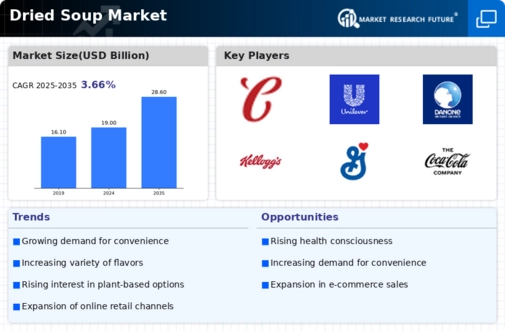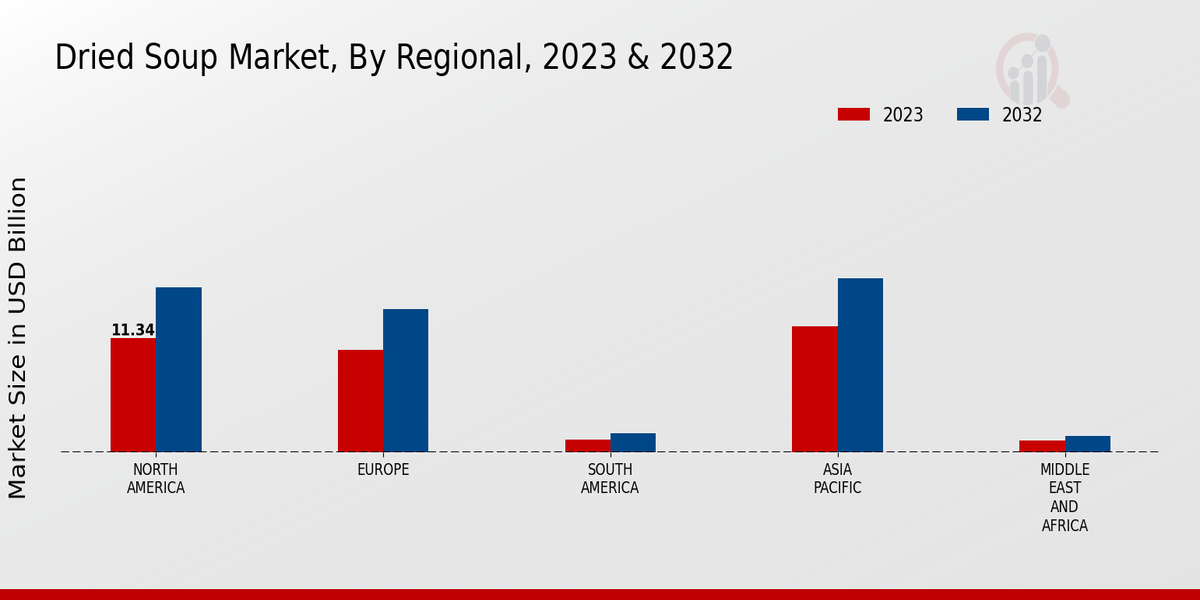Expansion of E-commerce Platforms
The Global Dried Soup Market Industry benefits from the rapid expansion of e-commerce platforms, which facilitate easier access to a variety of products. Online shopping has transformed consumer purchasing behavior, allowing individuals to explore a wider range of dried soup options from the comfort of their homes. This trend is particularly relevant in urban areas, where busy lifestyles limit traditional shopping time. E-commerce platforms often provide detailed product information and customer reviews, enhancing consumer confidence in their purchases. As a result, the market is expected to witness sustained growth, with projections indicating a rise to 28.6 USD Billion by 2035, driven by the convenience and accessibility of online shopping.
Innovations in Product Development
The Global Dried Soup Market Industry is characterized by continuous innovations in product development, which play a crucial role in attracting consumers. Manufacturers are increasingly focusing on creating unique flavors, textures, and health-oriented formulations to differentiate their offerings. This includes the incorporation of superfoods and plant-based ingredients, which resonate with the growing trend towards vegetarian and vegan diets. Such innovations not only cater to diverse consumer preferences but also enhance the overall appeal of dried soups. As the market evolves, these advancements are likely to contribute to a compound annual growth rate of 3.82% from 2025 to 2035, indicating a robust future for the industry.
Rising Demand for Convenience Foods
The Global Dried Soup Market Industry experiences a notable surge in demand for convenience foods, driven by the fast-paced lifestyle of consumers. As individuals seek quick meal solutions, dried soups offer an appealing option due to their ease of preparation and long shelf life. In 2024, the market is projected to reach 19.0 USD Billion, reflecting a growing preference for ready-to-eat meals. This trend is particularly pronounced among busy professionals and families, who prioritize convenience without sacrificing nutrition. The increasing availability of diverse flavors and formulations further enhances the attractiveness of dried soups, positioning them as a staple in modern diets.
Market Trends and Growth Projections
The Global Dried Soup Market Industry is projected to experience substantial growth, with key metrics indicating a promising future. In 2024, the market is anticipated to reach 19.0 USD Billion, with expectations to expand to 28.6 USD Billion by 2035. This growth trajectory suggests a compound annual growth rate of 3.82% from 2025 to 2035, reflecting increasing consumer interest in dried soup products. Factors contributing to this growth include rising health consciousness, the expansion of e-commerce, and innovations in product development. As these trends continue to evolve, the market is likely to adapt, ensuring a dynamic and responsive industry landscape.
Increasing Global Population and Urbanization
The Global Dried Soup Market Industry is poised for growth due to the increasing global population and urbanization trends. As more individuals migrate to urban areas, the demand for convenient meal options rises. Urban dwellers often seek quick and nutritious solutions that fit their busy lifestyles, making dried soups an attractive choice. This demographic shift is expected to drive market expansion, as urban populations tend to have higher disposable incomes and greater access to diverse food products. Consequently, the market is likely to experience sustained growth, aligning with broader demographic trends that favor convenience and accessibility in food consumption.
Health Consciousness and Nutritional Awareness
The Global Dried Soup Market Industry is significantly influenced by the rising health consciousness among consumers. As individuals become more aware of their dietary choices, there is a growing preference for soups that offer nutritional benefits. Many dried soups are fortified with vitamins and minerals, catering to health-oriented consumers. This trend is evident in the increasing demand for organic and low-sodium options, which align with contemporary dietary preferences. The market's expansion is further supported by the introduction of innovative products that emphasize health benefits, thereby appealing to a broader audience. This shift towards healthier eating habits is likely to sustain growth in the sector.





















